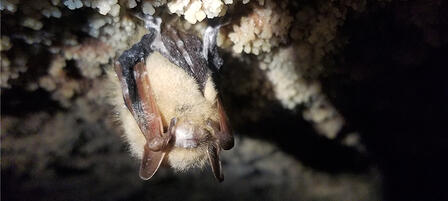Fungus That Causes White-nose Syndrome In Bats Spreading In Kansas

PRATT – A survey conducted in March in Rooks County has confirmed the presence of the fungus, Pseudogymnoascus destructans (Pd), known to cause white-nose syndrome (WNS) in bats. Though the fungus was detected, no bats showed signs of white-nose syndrome at the time of the survey.
WNS is not known to pose a threat to humans, pets, livestock, or other wildlife and fish.
White-nose Syndrome
White-nose syndrome is a fungal disease that affects hibernating bats. The fungus is spread through bat-to-bat contact, but not all bat species are affected equally. WNS is named for the white fungal growth observed around the nose of infected bats. The fungus can invade the skin of hibernating bats and cause damage to the wings. It triggers hibernating bats to use up fat reserves, forcing them to leave the hibernacula in search of food. This occurs in the middle of winter when outside conditions are harsh and food (insects) is scarce, ultimately leading to death by starvation and/or dehydration. To date, white-nose syndrome has been confirmed in 33 states and seven Canadian provinces. White-nose syndrome was first detected in Kansas in 2018 in Barber, Cherokee, Comanche, Kiowa, and Pratt counties.
Surveys and Observations
Surveys in Kansas were conducted in 2019 between February 22 and April 18, and samples were tested by the U.S. Geological Survey National Wildlife Health Center in Madison, Wis. Counties surveyed included Barber, Comanche, Crawford, Geary, and Rooks. Sites surveyed in Geary and Crawford counties were negative for Pd; however, negative results do not guarantee the absence of Pd at a location, as small amounts of Pd may evade detection by the diagnostic test. Conversely, survey results confirmed the spread of WNS at sites known to have Pd in Barber and Comanche counties. In these areas, biologists observed an increasing number of symptomatic cave myotis and tri-colored bats, with tri-colored bats most affected.
The fungus and/or WNS have been detected in surrounding states, including Missouri, Nebraska, and Oklahoma. Wildlife experts recommend decontamination protocols, https://www.whitenosesyndrome.org/resource/united-states-national-white-nose-syndrome-decontamination-protocol-april-12-2016, for anyone who works with bats or conducts cave surveys to help reduce and prevent the spread of the fungus.
Questions regarding WNS in Kansas can be directed to samantha.pounds@ks.gov or KDWPT.ess@ks.gov. For media requests, contact the KDWPT Ecological Services section at (620) 672-5911.
For more information, visit https://www.whitenosesyndrome.org/.
(Grant provided funding – Endangered Species Recovery Implementation Funds, CFDA Program #15.657.)
-30-







